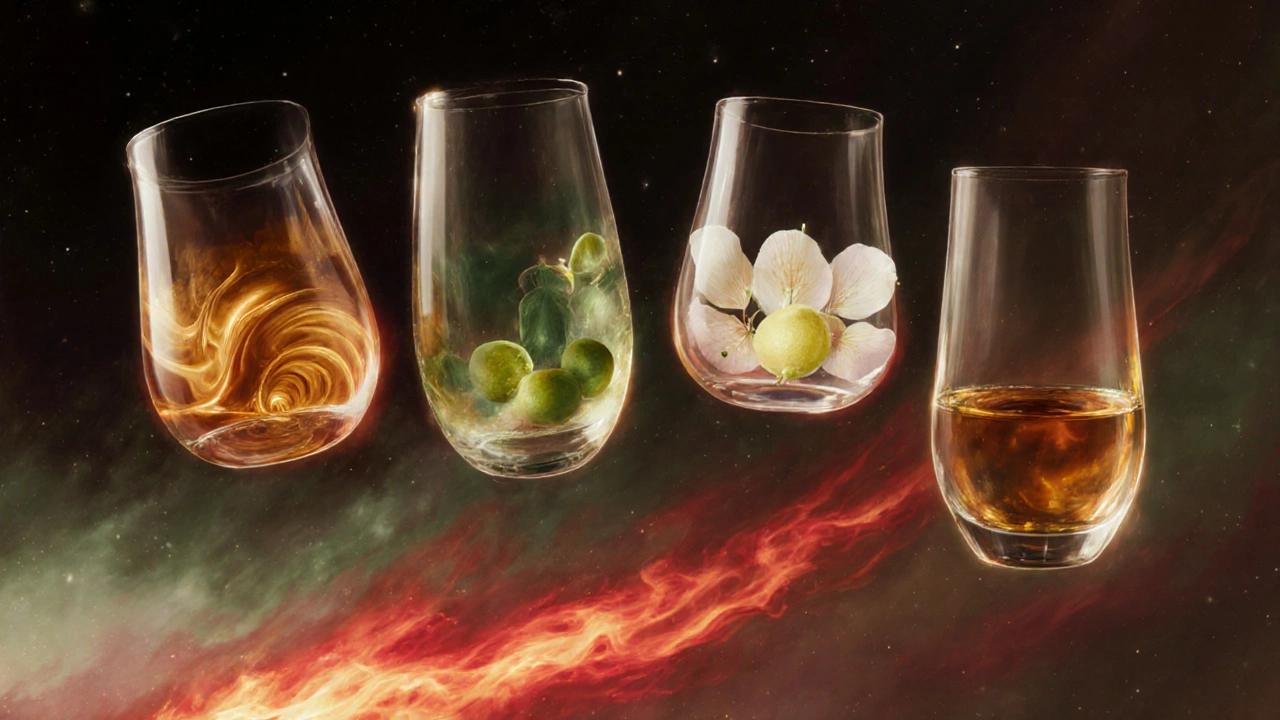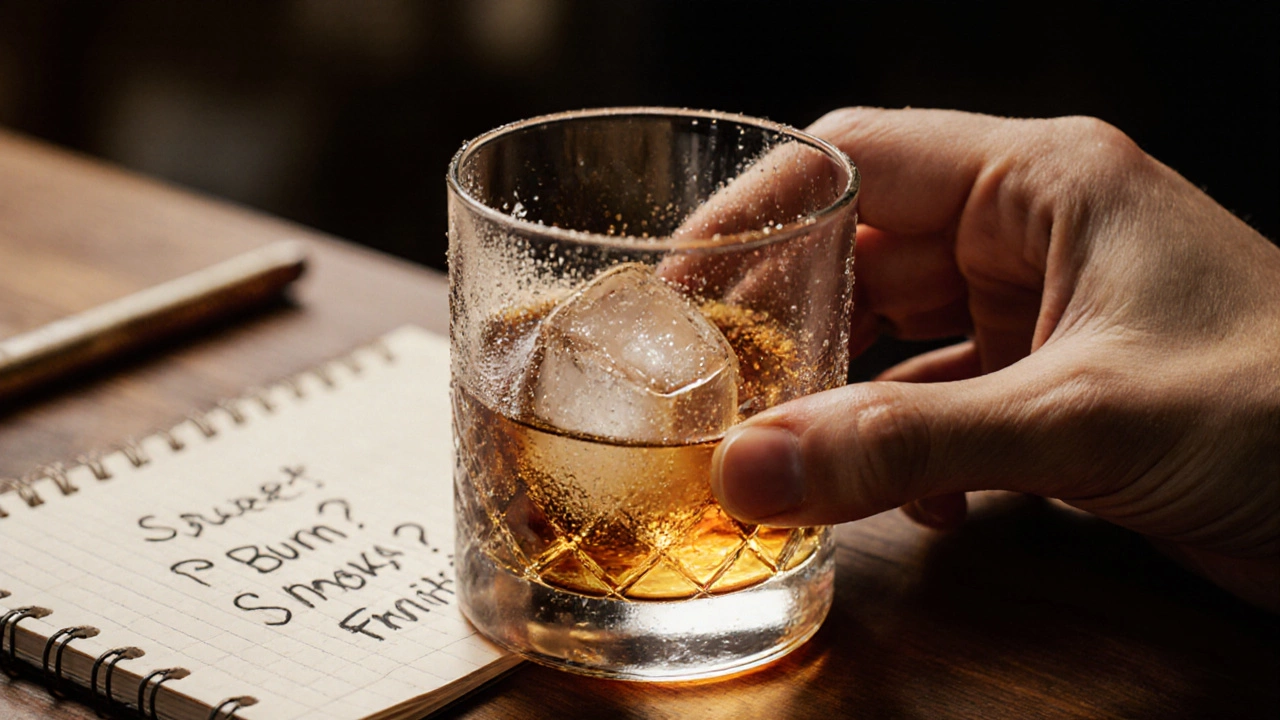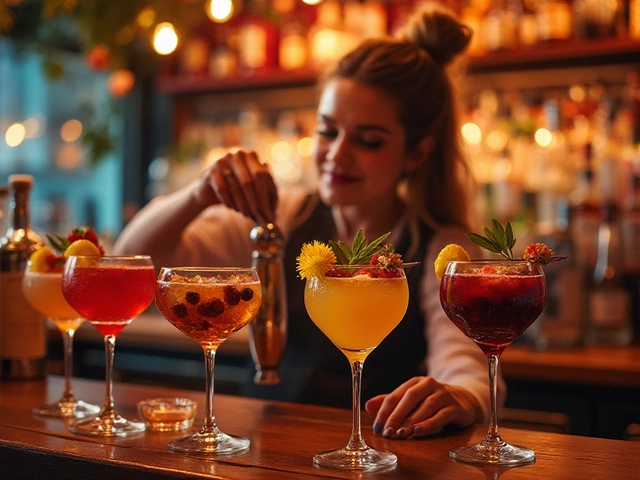Whiskey Burn Reduction Calculator
Reduce the Burn Without Losing Flavor
Most beginners find whiskey too harsh because the alcohol burn masks flavors. Adding the right amount of water reduces the burn while revealing more complex flavors.
Recommended Water Addition
For your whiskey, add:
drops of water
This reduces burn while preserving key flavor notes
Why this works:
Water breaks down alcohol molecules that mask flavor compounds. At 30ml, 6-8 drops (about 0.3ml) is the optimal dilution according to a 2023 Whisky Advocate study.
Tip: Add water slowly while smelling between drops to find your perfect balance.
Most people take their first sip of whiskey and think, What is this? It burns. It’s strong. It doesn’t taste like anything they’ve had before. Maybe they expected something sweet like bourbon candy or smooth like vodka. Instead, it hits like a punch to the throat. That’s normal. And it doesn’t mean you’re not supposed to like whiskey-it just means you haven’t learned how to taste it yet.
Why whiskey feels overwhelming at first
Whiskey is typically bottled at 40-50% alcohol by volume (ABV). That’s way stronger than wine or beer. When you take a sip, the alcohol doesn’t just warm your mouth-it burns. That burn masks everything else. It’s like trying to hear a whisper in a hurricane. Most beginners can’t pick out caramel, vanilla, or smoke because their tongue is busy screaming, “This is too much!” A 2022 survey of over 1,200 first-time whiskey drinkers found that 78% said the alcohol burn made it hard to notice any flavors at all. That’s not your fault. It’s just how the spirit works. The good news? That burn fades with time-and so do the confusing flavors-if you know how to approach it.What whiskey actually tastes like (broken down by type)
Not all whiskey tastes the same. There are four main types you’ll see on shelves, and each has a totally different flavor profile. For beginners, some are much easier to start with than others.- Bourbon (USA): Made mostly from corn, aged in new charred oak barrels. This gives it sweet, smooth notes of caramel, vanilla, honey, and toasted oak. It’s the most popular choice for beginners-68% of new drinkers prefer it. Try Buffalo Trace or Maker’s Mark. Both are around 45% ABV, which is high enough to have flavor but low enough to not overwhelm. You’ll taste the sweetness before the burn.
- Irish whiskey (Ireland): Triple-distilled for extra smoothness. It’s lighter, cleaner, and often has hints of citrus, green apple, or subtle malt. Jameson is the classic beginner pick. It doesn’t have smoke or heavy oak. It’s like drinking a gentle, slightly sweet tea with a kick.
- Scotch (Scotland): This is where things get tricky. Some Scotch is smoky, peaty, and medicinal-like campfire smoke and wet rocks. That’s not for beginners. But not all Scotch is like that. Glenlivet 12 Year Old is light, fruity, and floral. It has less than 1.5 ppm of peat smoke (compared to 55 ppm in heavily peated ones like Ardbeg). If you want to try Scotch, start here.
- Japanese whisky (Japan): Think of this as the quiet cousin of Scotch. It’s delicate, refined, and often has notes of pear, white flower, or light honey. Suntory Toki is a great starter. It’s not too strong, not too smoky, and finishes clean.
- Rye whiskey (USA/Canada): Spicy, bold, and peppery. Think cinnamon, black pepper, and dried fruit. It’s the hardest for beginners-only 12% of new drinkers like it on first try. Save this one for later.
How to taste whiskey (the right way)
You don’t need fancy gear. But you do need to slow down. Here’s how to actually taste whiskey instead of just drinking it:- Look: Pour a small amount (about 30ml) into a Glencairn glass if you have one. If not, any wide-bottomed glass works. Tilt it and watch how the liquid runs down the sides. Thicker trails mean more body-and usually more flavor.
- Smell: Don’t stick your nose deep in the glass. Hold it about an inch above and breathe in gently through your mouth and nose at the same time. That’s called “nosing.” You’re looking for three things: sweetness (caramel, vanilla), fruit (apple, pear), or earthiness (wood, smoke). Don’t force it. Just notice what comes up.
- Taste: Take a tiny sip. Let it sit on your tongue for 5 seconds. Don’t swallow yet. Swirl it gently around your mouth. Notice where it hits-front, sides, back. The burn will come, but now you’re not just reacting to it. You’re listening to it.
- Finish: Now swallow. How long does the flavor stick around? A good whiskey lingers for 15-30 seconds. If it disappears fast, it’s probably simple. If it changes-maybe turns fruity or spicy-that’s complexity.

Do you need to add water or ice?
Yes. And no. It depends. Traditionalists say “neat only.” But here’s what actually works for beginners: add a drop or two of water. Water opens up the flavors trapped by the alcohol. You’ll suddenly taste things you missed before-honey, dried fruit, even chocolate. A 2023 study from Whisky Advocate found that 57% of beginners noticed more flavor after adding water. Ice? Also okay. One cube cools the whiskey and slightly dilutes it, making it smoother. It won’t give you the full flavor profile, but it makes the first sip less scary. Think of it as training wheels.What to buy as your first whiskey
You don’t need to spend $100. In fact, spending more doesn’t mean it’s better for you right now. Stick to the $30-$60 range. Here are four beginner-friendly bottles that actually deliver:- Bourbon: Buffalo Trace ($35) - Smooth, sweet, balanced. The gold standard for new drinkers.
- Irish: Jameson ($32) - Light, easy, great for sipping or mixing.
- Scotch: Glenlivet 12 ($50) - Fruity, clean, no smoke. The gateway to Scotch.
- Japanese: Suntory Toki ($45) - Delicate, floral, gentle finish.

How long until you start tasting flavors?
It’s not magic. It’s practice. Most beginners start noticing real flavors after 3-5 tastings. That doesn’t mean drinking five shots in one night. Spread it out. One whiskey per week, 30 minutes, no distractions. Use the “observe, nose, taste, finish” method every time. Keep a simple note: “Sweet? Burn? Smoky? Fruity?” A 2023 report from the Society of Whiskey Writers found that 87% of beginners who followed this routine said they enjoyed whiskey more within two weeks. One Reddit user wrote: “I hated whiskey on day one. After three weeks of trying one sip a week with water, I started tasting vanilla. I cried.”What to avoid as a beginner
- High-proof whiskeys (over 50% ABV): Too intense. You’ll just get burned.
- Peated Scotch (Ardbeg, Laphroaig): Smoky, medicinal, intense. Save it for when you’ve tried 20 other whiskeys.
- Rye whiskey (Bulleit Rye, Sazerac): Spicy and sharp. It’s not a starter.
- Flavored whiskey (cinnamon, apple, honey): These aren’t real whiskey. They’re candy with alcohol. They teach your palate to expect sweetness, not complexity.
The long game: Your whiskey journey
Whiskey isn’t about getting it right on the first try. It’s about learning how to listen. Your taste buds change. Your tolerance grows. What tasted like fire last month might taste like caramel tomorrow. The goal isn’t to become a critic. It’s to find what you like. Maybe you’ll stick with bourbon forever. Maybe you’ll fall for a smooth Irish whiskey. Maybe one day you’ll try a smoky Scotch and think, “This is amazing.” The industry is catching on. Distilleries now make beginner-friendly bottles. Jameson launched a cold-brewed whiskey. Maker’s Mark sells tasting kits with three levels of flavor. The Scotch Whisky Association even has an AI tool that recommends whiskey based on your favorite foods. You’re not behind. You’re just starting. And that’s okay.Does whiskey taste better with water?
Yes, for beginners. Adding a few drops of water (6-8 drops per 30ml) helps release flavors hidden by the alcohol. It doesn’t ruin the whiskey-it reveals it. Many professional tasters add water to high-proof whiskeys for this reason. It’s not cheating. It’s technique.
What’s the best whiskey for someone who hates the burn?
Start with Irish whiskey like Jameson or a light bourbon like Maker’s Mark. Both are around 40-45% ABV, which is lower than most. Add one ice cube to cool it down and slightly dilute it. The burn fades, and the sweetness comes through. You can also try Suntory Toki-it’s designed to be gentle on the palate.
Can I mix whiskey with soda or juice as a beginner?
You can, but it won’t help you learn what whiskey tastes like. Mixing it hides the flavor. If you want to enjoy whiskey, sip it neat or with water first. Once you understand the base flavor, then try a whiskey highball (whiskey + soda water) or a simple Old Fashioned. But don’t start there.
Why does whiskey taste different every time I try it?
Your palate changes. So does your mood, your environment, and even the temperature of the room. Also, whiskey is a living drink-it opens up over time in the glass. The first sip might taste hot. The fifth sip, after letting it sit, might taste fruity. That’s normal. Don’t panic. Just observe.
How often should I taste whiskey as a beginner?
Once a week is perfect. Taste one whiskey at a time. Don’t rush. Give your palate a break between sips-wait 5 minutes. Overdoing it leads to fatigue. You’ll start noticing more flavor after 3-5 sessions. It’s not about quantity. It’s about attention.


